Through the leadership of Georgia Tech Executive Vice President for Research, Chaouki Abdallah, PhD, and Julia Kubanek, Vice President for Interdisciplinary Research, GCMI has dedicated annual funding for medtech innovation at Georgia Tech. The funding underscores the institute’s commitment to successful commercialization of promising medical technologies brought forth by Georgia Tech researchers, investigators, faculty and students.
Funding, which varies in specific levels from fiscal year to fiscal year, specifically supports projects we believe have high potential for successful commercialization, follow on funding and improved patient outcomes. Funded projects are selected by GCMI leadership inclusive of consultation with the board of directors.
Unlike other well-known funding sources, these funds specifically support commercialization activities, not for staff / salary or lab support.
GCMI Director of Scientific Affairs Evan Goldberg offers the following answers to frequently asked questions.
Is there a cap per project?
No. Funding levels per project are based on promise and potential, unmet need and a technology’s ‘location’ in the commercialization pathway. Financial ‘intensity’ typically increases the closer a technology comes to a major commercialization milestone like regulatory approval, licensing, start-up spinout or outright sale to a larger medtech enterprise that commonly innovates through acquisition. Funding levels can range from $5k to $50k or more in line with our proven, phase-gated process.
Project success is dependent on careful consideration of several intersecting aspects: technological, clinical, commercial and legal. We follow a structured, phase-gated process that allows for a disciplined medical device design and product development approach. Our medical device design services and development process encourages an early focus on clear problem definition and de-risking a wide variety of potential solutions. By later phases, the funnel of medical device design options narrows significantly, converging on a final product that has been thoroughly shown to meet the customer needs and is ready for distribution.
Is there a hard deadline for funding applications?
No. Resources are allocated with each new fiscal year. The GCMI team assigns funds to projects we deem promising on a rolling basis until the fiscal year’s funds have been exhausted.
More specifically, what are the criteria for funding?
The criteria for funding are directly informed by our team’s experience and our belief in a technology’s likelihood of commercial success, follow on funding and fit with our own capabilities. Whether it is a full Phase Zero initiative, solely a market, IP or regulatory assessment, a detailed Phase 2 design and development endeavor, preclinical work or clinical trial support, we have the liberty to use every tool in our toolbox at almost any phase in a technology’s commercialization pathway in the interest of not only accomplishing a specific milestone driven project mission, but the larger goal set by the EVPR and VPIR’s offices.
Practical examples
Scott Hollister – most recently, clinical trial support for his groundbreaking 3D printed, bioresorbable tracheal implant technology
Omer Inan – Phase 2 design and development activities for IV infiltration technology
Phase Zero – multiple examples – in whole and in part – including market assessment, clinical need assessment, regulatory landscape assessment, technical development including design history files, verification and validation testing
Pilot Preclinical Studies – small proof of concept studies in large animal models
Phase Two – Design and Development
What else should GT faculty, researchers, etc. know?
“We are a resource to help you do navigate the commercialization pathway from ‘bench to bedside’ so you can focus on your students, your lab, your research and your technologies. We are here to help you succeed in taking your technology out of the lab, off of the bench and into the realm of value and improved patient outcomes.”
 The Top Five Funding Sources for GT Faculty, Researchers and Investigators – AT PHASE ZERO
The Top Five Funding Sources for GT Faculty, Researchers and Investigators – AT PHASE ZERO
If you are a researcher, engineer, principal investigator or faculty member with what you believe is an idea for a new medical technology that’s ready for its own investigation of its potential, where will the funds for these critical, early stage commercialization activities come from?
